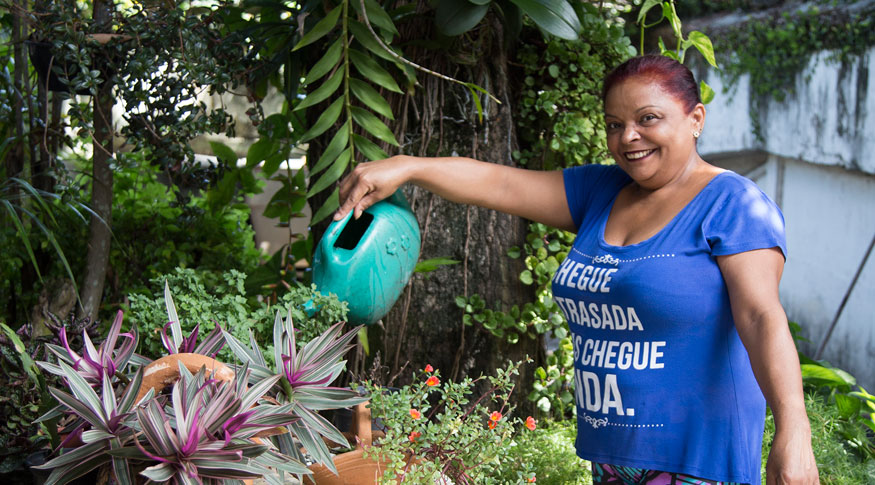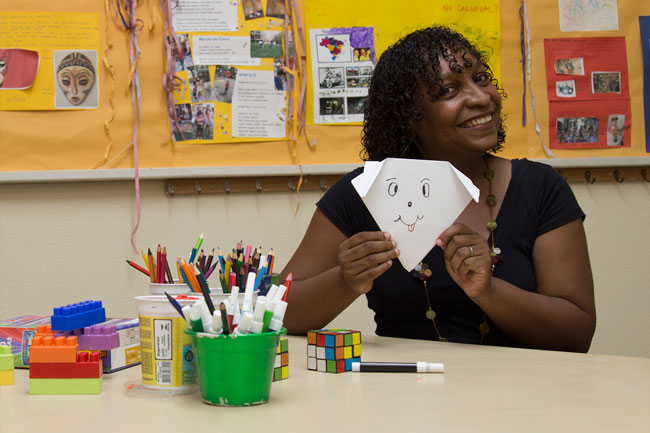Revista Retratos
Labor market reflects gender inequalities
August 19, 2019 02h05 PM | Last Updated: August 21, 2019 12h40 PM

Wilma Fernandes works three hours a day per week as a diarist - Photo: Licia Rubinstein/ IBGE News Agency
Almost the entire Brazilian female population (92.6%) aged 14 years old and over, representing more than 80 million persons, performs household chores and people caring, on an average of 21 weekly hours, according the Continuous National Household Sample Survey (Continuous PNAD) data, relative to the fourth quarter of 2018.
These activities are categorized in the survey as “Other forms of work”, and are essential to reproduce social life, as Eleutéria Amora from Casa da Mulher Trabalhadora (House of Working Woman - Camtra) explains. “If women cook for someone who works out, if they take children to school, who sometimes isn’t even their kids, for someone go work, they are involved in the society sustenance”, she exemplifies.
Even after being integrated to the labor market, it is still very usual in women´s life what is known as double journey: the formal work added up to cleaning and house care routine.
The double journey phenomenon is considered as an obstacle to increase the women participation in the workforce. In 2018, the women’s participation rate was so far 20% lower than men (52.7% in the fourth quarter of 2018 against men’s 71.5%).
According to Bábara Cobo, IBGE’s Population and Social Indicators coordinator, the working women either perform a double journey or employ another woman to substitute them in the house labor: “most of times spending all their salary to hire someone to do the service”.
Professions designated by or for women
The social roles seen as female or male one still have great influence in the choice of professions and salary disparity. As a major example, the paid domestic work is an occupation with high index of women in Brazil. According to the Continuous Pnad, from more than 6.2 million employed as domestic workers, 4.5 million (94.1%) are women.
Most part of the domestic workers still work without a formal contract and earn, on average, R$740, an amount under the national minimum wage of R$1,245. The salary also changes when it is disaggregated by gender: while the average salary of the 280 thousand male domestic workers was of R$1,019.61 in the last quarter of 2018, the women’s average was of R$846.12.
The difference is partly explained by the measure of worked hours. The diarists, for example, can set a schedule with different contracts, working in more than one residence. In this schedule, women use to work less than 40 weekly hours, most of times to accommodate with their own household chores. In the last quarter of 2018, the average worked hours of women was 31 hours, while men’s was 42.
The sentiment role in gender matters
In the people caring sector, the distribution of employed persons leans on women’s side, mainly among babysitters, with 96,4% of female participation. In education, the younger the segment, the higher the proportion. The kindergarten women educators are almost the whole sector (97,3%).

Veroice Diniz is a kindergarten teacher and had already been a babysitter. Photo: Licia Rubinstein/ IBGE News Agency
According to Barbara Cobo, “The idea is that women were “born” to be mothers, they were “born” to care. So, she ends up being conditioned to attend these expectations, that are hard to be broken.”
Maria Claudia Coelho, anthropologist and teacher of Instituto de Ciências Sociais do Estado do Rio de Janeiro (Social Sciences Institute of the University of the State of Rio de Janeiro– UERJ), completes the idea: “In the modern western world, emotion is seen negatively as a gap for disorder and femininity, while sense is associated with control and masculinity. Nevertheless, this valuation reverses when emotion, associated with femininity, is now positive because it is related to empathy, comprehension, solidarity, attributes there are of lesser extent or missing in masculinity.”
Check the complete story in the 17th edition of Retratos Magazine.


















